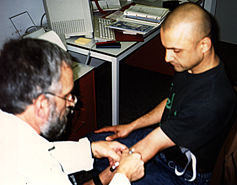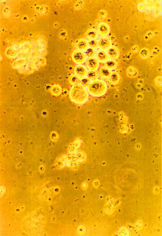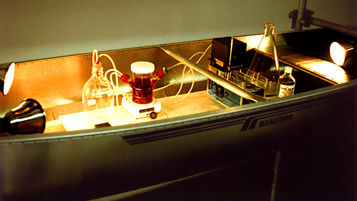|
|

|
||
|
|
Present Past Subjects Projects Misc |
GOOD AND EVIL ON THE LONG VOYAGE (1997)
is the title of a work produced in collaboration with Prof. Dr. Frans Ramaekers and Mr. Wiel Debie from the Department of Molecular Cell Biology & Genetics, University of Maastricht for the exhibition 'Preservations' which took place between the 13th of December 1997 and the 1st of February 1998 in the former Bonnefanten Museum Maastricht.  Wiel Debie taking a blood sample in order to isolate my lymphocytes. For the work a 'new cell' called a hybridoma was created by fusing one of my own white blood cells (lymphocytes) with the cancer cell (myelomas) of a mouse. The success rate for such cross-species trans-gene fusions is very low- in our case there were only a couple of successful fusions out of approximately 10 million attempts. Only when the researchers showed suprise that it worked at all did I realise exactly how unique our fusions were.  The (clustered) hybridoma cells as photographed under a microscope. Why did I do it? A couple of reasons: To begin with, I'm very interested in the discussion around immortality and radical life-extension. The hybridoma culture we created is, in principle, 'immortal'. Thanks to the cancerous nature of the specific mouse cell-line we used, some of my own genetic material will continue to live and divide forever (in a cell culture) and will not succumb to cell death (apoptosis). Of course not all of my genes made it into the hybridoma- the surviving germ plasm is part man and part mouse, a mixture of white blood cell and cancer. 'Good and Evil on the Long Voyage' is a hybrid- and it was curiousity about hybrids that started my mind in this direction in the first place. The project began with a desire to identify and elaborate the 'Genesis Barrier', the form that maintains difference, the wall that separates difference in species. I found the barrier (initially) in the zona pellucida that surrounds the female egg. By way of empirical experiment and proof, I had planned to explore (and transgress) a 'foreign zona' using a technique called ICSI (for Inter Cytoplasmic Sperm Injection). Unfortunately using the technique would have jeopardized the existence of the laboratory where we planned to do the work, as ICSI is currently under considerable fire, both for ethical as well as safety reasons. As it turns out our creation of a hybridoma turned out to be a less controversial (but probably much more radical) method to 'do some art' in respect to convergence and divergence.  The bioreactor in the canoe. The culture is in the pink colored flask. What was there to see? Through out my period in the laboratory I was struck by how invisible molecular biology actually is- all events are marked, mirrored and scaled up in a variety of ways to be measured by the observer. I like to think about art and biology in terms of genotype and phenotype. A cell or organism's genetic constitution or genotype is perhaps much more concrete than an art concept, as the genes can be read, measured and re-recorded precisely. In some ways however, genotype and art concept are similar- both depend on a corresponding phenotype or genetic expression to get passed on into the next generation. The phenotype is the expression of the genes and art concept made physical in the world as body, entity or art work. For the exhibition, I insisted on the hybridoma being physically present (no pictures man,- I want the real thing). A cell culture is usually maintained in an intensive care unit called a bio-reactor- a very expensive device. For the exhibition I was able to borrow a bio-reactor from New Brunswick Scientific. The bio-reactor with the hybridoma culture was placed in an aluminum canoe that was raised several meters above the floor in a scaffold. In order to see the bioreactor a mirror was suspended above the canoe.  The complete work on display in the former Bonnefanten Museum. ALAMUT.COM is artist owned and operated.
|
|